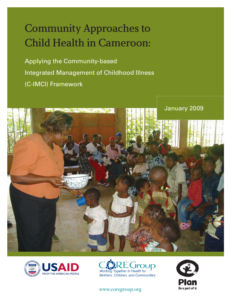ORGANIZATION
CORE Group
Plan
USAID
YEAR PUBLISHED
2009
DESCRIPTION
In 1992, the World Health Organization (WHO) and the United Nations Children’s Fund (UNICEF) developed the IMCI strategy to address the five major causes of child mortality (diarrhea, pneumonia, malaria, measles and malnutrition) using an integrated ‘whole child’ approach. This strategy recognizes that children often suffer from multiple illness events at the same time or in close proximity to each other, yet are typically diagnosed by health personnel only for the reported illness. Using a set of flow charts and guidelines, trained health care providers can classify and treat a range of nutritional and infectious disease problems that commonly affect children in that country. In addition to facility-based training, IMCI also recognized the importance of improving the health system infrastructure and supplies, and the role of community and households in determining mortality outcomes.This paper explores how the C-IMCI Framework was applied by Plan in Cameroon, its effectiveness as a strategic approach and the lessons learned from the Plan/Cameroon experience.

